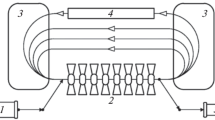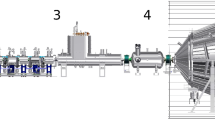Abstract
The development of a detuning system for the precision control of electron energy is a major challenge when electron targets are used in ion-storage rings. Thus, a high-precision, high-voltage, detuning system was developed for the electron target of a high-intensity heavy-ion accelerator facility-spectrometer ring (HIAF-SRing) to produce accurate electron–ion relative energies during experiments. The system consists of auxiliary, and high-voltage detuning power supplies. The front stage of the auxiliary power supply adopts an LCC resonant converter operating in the soft-switching state and an LC filter for a sinusoidal waveform output in the post-stage. The detuning power supply is a high-voltage pulse amplifier (HVPA) connected with a high-voltage DC (HVDC) module in series. In this paper, the design and development of the detuning system are described in detail, and the test bench is presented. The test results demonstrated that the detuning system conforms to the technical specifications of the dielectronic recombination (DR) experiment. Finally, a Fe15+ DR spectrum was measured using the detuning system. The experimental data demonstrated a good experimental resolution and verified the reliability and feasibility of the design.













Similar content being viewed by others
Data availability
The data that support the findings of this study are openly available in Science Data Bank at https://www.doi.org/10.57760/sciencedb.07941 and https://cstr.cn/31253.11.sciencedb.07941.
References
P. Beiersdorfer, N. Hell, J. Lepson, Temperature measurements using the dielectronic satellite lines of fe xvii. Astron. J. 864, 24 (2018). https://doi.org/10.3847/1538-4357/aad27f
S. Preval, N. Badnell, M. O’Mullane, Partial and total dielectronic recombination rate coefficients for W73+ to W56+. Phys. Rev. A. 93, 042703 (2016). https://doi.org/10.1103/PhysRevA.93.042703
E. Lindroth, H. Danared, P. Glans et al., QED effects in Cu-like Pb recombination resonances near threshold. Phys. Rev. Lett. 86, 5027 (2001). https://doi.org/10.1016/j.nimb.2008.10.040
S. Schippers, Relativistic, QED and nuclear effects in highly charged ions revealed by resonant electron–ion recombination in storage rings. Nucl. Instrum. Meth. B. 267, 192–195 (2009). https://doi.org/10.1016/j.nimb.2008.10.040
C. Brandau, C. Kozhuharov, Z. Harman et al., Isotope shift in the dielectronic recombination of three-electron Nd57+ A. Phys. Rev. Lett. 100, 073201 (2008). https://doi.org/10.1103/PhysRevLett.100.073201
S. Schippers, E. Schmidt, D. Bernhardt et al., Photorecombination of berylliumlike Ti18+: hyperfine quenching of dielectronic resonances. J. Phys. Conf. Ser. 58, 025 (2007). https://doi.org/10.1088/1742-6596/58/1/025
M. Lestinsky, E. Lindroth, D. Orlov et al., Screened radiative corrections from hyperfine-split dielectronic resonances in lithiumlike scandium. Phys. Rev. Lett. 100, 033001 (2008). https://doi.org/10.1103/PhysRevLett.100.033001
S.J.N.I. Schippers, Electron–ion merged-beam experiments at heavy-ion storage rings. Nucl. Instrum. Meth. B. 350, 61–65 (2015). https://doi.org/10.1016/j.nimb.2014.12.050
C. Brandau, C. Kozhuharov, M. Lestinsky et al., Storage-ring experiments on dielectronic recombination at the interface of atomic and nuclear physics. Phys. Scripta 2015, 014022 (2015). https://doi.org/10.1088/0031-8949/2015/T166/014022
R. Schuch, S. Böhm, Atomic physics with ions stored in the round. J. Phys. Conf. Ser. 88, 012002 (2007). https://doi.org/10.1088/1742-6596/88/1/012002
G.-F. Qu, W.-P. Chai, J.-W. Xia et al., Two-plane painting injection scheme for BRing of HIAF. Nucl. Sci. Tech. 28, 114 (2017). https://doi.org/10.1007/s41365-017-0260-5
Z.K. Huang, W.Q. Wen, X. Xu et al., Dielectronic recombination experiments at the storage rings: from the present CSR to the future HIAF. Nucl. Instrum. Method B. 408, 135–139 (2017). https://doi.org/10.1016/j.nimb.2017.04.024
T.M. Tang, L.J. Mao, H.J. Lu et al., Design of an efficient collector for the HIAF electron cooling system. Nucl. Sci. Tech. 32, 116 (2021). https://doi.org/10.1007/S41365-021-00949-0
V. Belaguli, A.K.S. Bhat, Series-parallel resonant converter operating in discontinuous current mode. Analysis, design, simulation, and experimental results. IEEE Trans. Circuits Syst. I Fund. Theory Appl. 47(4), 433–442 (2000). https://doi.org/10.1109/81.841845
R. Yang, H.F. Ding, Y. Xu et al., An analytical steady-state model of LCC type series–parallel resonant converter with capacitive output filter. IEEE. T. Power. Electr. 29, 328–338 (2013). https://doi.org/10.1109/TPEL.2013.2248753
A.K.S. Bhat, S.B. Dewan, Analysis and design of a high-frequency resonant converter using LCC-type commutation. IEEE Trans. Power Electron. PE-2(4), 291–301 (1987). https://doi.org/10.1109/TPEL.1987.4307864
K.M. Yan, X.M. Ma, J.B. Shangguan, et al., C.N. Patent 202110283776 (2021).
H.G. Kang, D.Q. Chen, L. Zhang et al., Electronic Technology Fundamentals: Analog part, 6th ed. (China: HEP, 2013), pp. 348–360.
H. Skolnik, Design considerations for linear optically coupled isolation amplifiers. IEEE. J. Solid-St Circ. 17, 1094–1101 (1982). https://doi.org/10.1109/JSSC.1982.1051866
K.M. Yan, Y.B. Zhou, X.M. Ma et al., High-voltage detuning power system of HIRFL-CSRm electron cooler for dielectronic-recombination experiments. Nucl. Instrum. Meth. A. 1046, 167699 (2022). https://doi.org/10.1016/j.nima.2022.167699
H.-M. Xie, K.-W. Gu, Y. Wei et al., A noninvasive Ionization Profile Monitor for transverse beam cooling and orbit oscillation study in HIRFL-CSR. Nucl. Sci. Tech. 31, 40 (2020). https://doi.org/10.1007/s41365-020-0743-7
D. Bernhardt, C. Brandau, Z. Harman et al., Breit interaction in dielectronic recombination of hydrogenlike uranium. Phys. Rev. A. 83, 020701 (2011). https://doi.org/10.1103/PhysRevA.83.020701
J. Linkemann, J. Kenntner, A. Müller et al., Electron impact ionization and dielectronic recombination of sodium-like iron ions. Nucl. Instrum. Meth. B. 98, 154–157 (1995). https://doi.org/10.1016/0168-583X(95)00095-X
L.J. Mao, X.D. Yang, J.W. Xia et al., Electron beam longitudinal temperatures of electron cooler on CSR. Chin. Phys. C. 30, 54–56 (2006)
A. Aleksandrov, N. Dikansky, N.C. Kot et al., Relaxations in electron beams and adiabatic acceleration. Phys. Rev. A. 46, 6628 (1992). https://doi.org/10.1103/PhysRevA.46.6628
N.S. Dikansky, V.I. Kudelainen, V.A. Lebedev et al., Ultimate Possibilities of Electron Cooling (Institute of Nuclear Physics, Novosibirsk, 1988), pp. 88–61.
Author information
Authors and Affiliations
Contributions
All authors contributed to the study conception and design. Material preparation, data collection and analysis were performed by Kai-Ming Yan, Ming-Rui Li, Yun-Bin Zhou, Xiao-Ming Ma, Jin-Bin Shangguan, Zhong-Kui Huang, Xiao-Jun Wang, Mei-Tang Tang, Jie Gao, Hou-Ke Huang, Da-Qin Gao and Li-Jun Mao. The first draft of the manuscript was written by Kai-Ming Yan and all authors commented on previous versions of the manuscript. All authors read and approved the final manuscript.
Corresponding author
Ethics declarations
Conflict of interest
The authors declare that they have no competing interests.
Appendix
Appendix
The components a, c, and e used in the imaginary transfer function calculation described in Eq. (1) were obtained using the following formula:
The components φ1, φ2, and φ3 used in formula (11) can be obtained by the following:
The components \(A_{1} ,A_{2} ,B_{1} ,B_{2} ,C_{1} ,C_{2} ,D_{1} ,D_{2} ,E_{1}\), and \(E_{2}\) in the transfer function of the equivalent detuning power supply described in Eq. (17) are obtained by the following formula:
Rights and permissions
Springer Nature or its licensor (e.g. a society or other partner) holds exclusive rights to this article under a publishing agreement with the author(s) or other rightsholder(s); author self-archiving of the accepted manuscript version of this article is solely governed by the terms of such publishing agreement and applicable law.
About this article
Cite this article
Yan, KM., Li, MR., Zhou, YB. et al. High-precision high-voltage detuning system for HIAF-SRing electron target. NUCL SCI TECH 34, 75 (2023). https://doi.org/10.1007/s41365-023-01214-2
Received:
Revised:
Accepted:
Published:
DOI: https://doi.org/10.1007/s41365-023-01214-2




